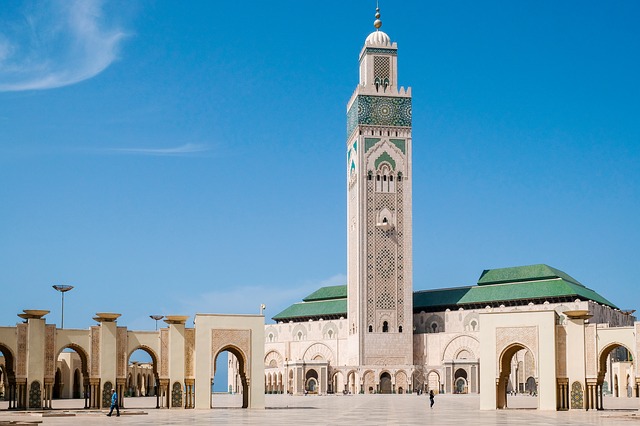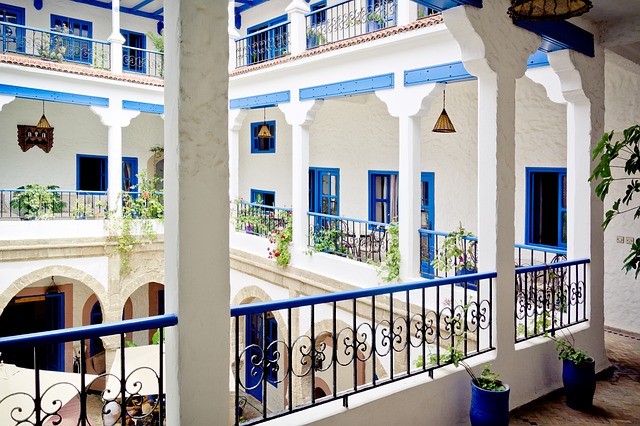Majestic Moroccan Architecture: Different structures, different designs
 |
| Majestic Moroccan Architecture Different structures, different designs |
Due to its unique location, Morocco has been influenced by many cultures over the years. Over the centuries the country was formed by the mixing of African tribes from the other side of the Sahara, Islamic traditions of its Arab neighbors and European colonial rulers. All of these influences have created a culture like no other, and nowhere is this more evident than in the country's unique architectural style.
From opulent palaces, grand gates and magnificent universities to mosques and religious schools, hammams, shrines and tombs, there are many impressive buildings to admire in Morocco. The imperial cities of Marrakech, Rabat, Fez and Meknes in particular have a number of beautiful legacies from former rulers, although there are numerous other striking buildings elsewhere in the country.
Today, different design elements can be seen in buildings across Morocco, but the strongest influence in the country's architecture (both past and present) is Islam. Indeed, Islam's specific decorating guidelines have been used in the construction and decoration of buildings in Morocco for centuries.
In addition to the Islamic influence, Spanish-Moorish architecture (a type of architecture characteristic of North Africa and the Iberian Peninsula) also took root in Morocco during the Almoravid dynasty. Today, a combination of these two particular styles can be found in most buildings across the country.
Understanding the wide variety of buildings in Morocco and their different architectural styles and elements can be overwhelming, so allow us to take you on a journey through the diversity of the elements.
Design elements in Morocco
Morocco is often described as a country full of charms, secrets, and beauty, which is certainly in part due to its unique architecture. Despite the country's sometimes tumultuous history, most of its artistic heritage has survived to this day.
Design elements of Moroccan architecture also have a strong Islamic influence. These include ornate geometric patterns, ornamental Islamic calligraphy of verses from the Koran and brightly colored zellij (a ceramic tile mosaic). In the center of most of the buildings there are also open courtyards with lush gardens: these were created as places of privacy and relaxation.
The Moorish style is also present in Moroccan architecture. Its main design elements include sharp white walls, stucco roofs between the arches, and large domes. The beauty of Moroccan architecture is that these elements are typically mixed in with Islamic-style buildings such as mosques and medersen (Koran schools).
What distinguishes Moroccan architecture is not only the extraordinary mix of different design elements, but also the uniqueness of each of its traditional buildings. Mosques, riads, souks, city walls, kasbahs, palaces and medersas are all different types of buildings that can be found across Morocco: They have different purposes and very different architectural designs. We'll get into some of them below.
Mosques
Mosques are arguably the most important structures in Morocco. In every city, village and town - no matter how small - you will find at least one mosque with a tall minaret that towers over the city. With walls and fountains covered in green and white zellij, and a beautifully ornate mirhab (a niche that shows the direction to Mecca) made of stucco and marble, it's no wonder that visitors find Moroccan mosques the epitome of Moroccan architecture. Some of the most exquisite examples of Moroccan mosques can be found in the spiritual city of Fes, particularly the Al-Qarawiyyin Mosque. Remember, only the Hassan II Mosque in Casablanca and the Tin Mal Mosque in the rural High Atlas Mountains are open to non-Muslims to view the buildings.
 |
| Majestic Moroccan Architecture Different structures, different designs |
Koutoubia Mosque, Marrakech
The Koutoubia Mosque dates from the late 12th century and is almost on the site of an older mosque. It is one of the main symbols of Marrakech. Although non-Muslim visitors are not allowed inside the great mosque, the main point of interest is outside: the towering minaret. The red sandstone minaret is one of the best examples of Almohad architecture. It has influenced other designs across the country and beyond as well. In fact, it could be said to be the blueprint for Moorish architecture in Morocco.
The tower has intricate carvings in the masonry and arches with jagged edges. There is also a wide ceramic tile surround near up and jagged pinnacles on top of the walls. Look carefully and you will find that the opposite sides of the tower have alternating patterns. There are four copper balls on the tower. While this is common in Moroccan architecture, it is normal for there to only be three spheres.
Mosque and University of Al Quaraouiyine, Fez
The oldest university in the world, the University of Al Quaraouiyine in Fez, can trace its history back to the year 859. Originally built in a fairly simple style, it has seen many changes, enlargements, and embellishments over the years. Andalusian designs are prominent when Hispanic Islamic styles became popular in Morocco with the arrival of Muslims from Andalusia. Geometric floral designs, ancient kufic calligraphy, ornate stucco work, gleaming marble, and ornate domes were all among the early designs.
A lot of work was done during the Marinid dynasty. In fact, this was the mosque's golden age. Elegant arches, towering columns and a huge chandelier were added. The original minaret was protected by plaster and bright white paint. During the Saadi dynasty, pavilions were built in the courtyards and the Alaouites carried out extensive restoration work. Today, the mosque and university not only display magnificent Moroccan designs, but also a mix of styles that were in vogue at different times in the country's past.
 |
| Majestic Moroccan Architecture Different structures, different designs |
Mohammed V Mausoleum, Rabat
The Mohammed V Mausoleum is located in the Moroccan capital Rabat and houses the remains of two former Moroccan kings. It was built for Mohammed V, two of his sons, the former King Hassan II. And his brother Prince Abdallah, were later buried here. The attractive white marble mausoleum is covered with a green pyramidal roof. Armed guards stand outside. A large golden royal object, the pillars of an unfinished mosque and the tall Hassan tower add to the external grandeur.
Non-Muslim visitors are allowed in. Colorful tiles, marble columns, granite floors, decorative fountains, and ornate carvings on the doors and ceiling add to what is often referred to as one of the most impressive examples of modern Moroccan architecture from the Alaouite era. Look at the tombs, bathed in the light of the great chandeliers, from the observation deck and you will see that it is indeed a fitting tribute to a king.
Riads
Traditional houses and palaces are called riads in Morocco. As private residences, they were built with seclusion in mind. They face inward, with a central courtyard that offers both family privacy and protection from Moroccan weather. All rooms open onto this courtyard and have windows only to this central room. The courtyards are often decorated with a fountain and orange or lemon trees. Depending on the wealth of the family, the riad can be decorated with sumptuous zellij and stucco work. In Marrakech and Essaouira, many old riads have recently been renovated and many have now been reused as hotels and restaurants.
 |
| Majestic Moroccan Architecture Different structures, different designs |
Medersas
More than just schools of religious teaching, Merdera's were true thriving centers for the study of law, philosophy, and astrology. Its architectural design is unique in that it represents a great disparity: In contrast to the extremely small and simple wooden bedrooms of the students, there was an incredibly decorated gate and a huge central courtyard, which was lined with splendidly decorated arches with detailed stucco work. The mosque enclosed within the towering school walls was also exquisitely decorated with lively Islamic calligraphy and complex geometric motifs on bright green and white zellij. It's difficult to capture the incredible contrast of decor in these schools, so be sure to visit the Bou Inania Medersa in Fez to see one of the most beautiful examples in the country.
In addition to the specific sites we mentioned earlier in this article, there are numerous cities and areas in Morocco where you can experience the heyday of the country's beautiful architectural style in all its glory.
The cities of Marrakech and Fes are usually the main places travelers visit as these two cities offer the greatest diversity in a small space. Notable buildings to visit include the Bahia Palace and Saadian Tombs in Marrakech, the Andalusian Mosque and the Museum of Moroccan Arts in Fez.




.jpg)








0 comments:
Post a Comment